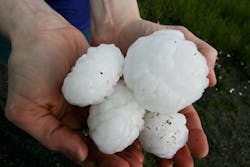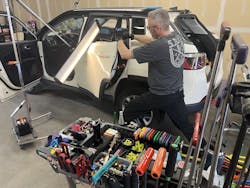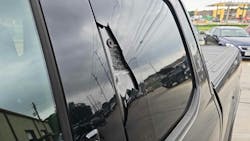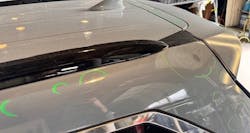Weather can make a big difference when it comes to many professions such as agriculture, transportation, construction, and so on. Collision repair falls on that list too, especially for hail.
Due to climate change, there is a possibility that hail will be more widespread in the U.S. and occur with higher frequency, and possibly even bigger sizes. Are repairers prepared for such a reality?
FenderBender sought out the answer from paintless dent/hail repairers across the country in mid-May 2024. Mo Kayeni of Elevated Auto Hail Repair, a new venture in paintless dent repair based in Centennial, Colorado, that services the whole state, helped FenderBender get an answer. Although his business opened this year, Kayani’s experience spans four years in the industry.
Before we dive into the answer to this industry question, we should get the science right.
What is Hail?
Hailstones are formed when raindrops are carried upward by thunderstorm updrafts into extremely cold areas of the atmosphere and freeze.
Hailstones then grow by colliding with liquid water drops that freeze onto the hailstone’s surface. If the water freezes instantaneously when colliding with the hailstone, cloudy ice will form as air bubbles will be trapped in the newly formed ice.
However, if the water freezes slowly, the air bubbles can escape, and the new ice will be clear. The hail falls when the thunderstorm’s updraft can no longer support the weight of the hailstone, which can occur if the stone becomes large enough or the updraft weakens.
"It's a depreciating asset, but it's an asset nonetheless"
Although Florida has the most thunderstorms, Nebraska, Colorado, and Wyoming usually have the most hailstorms. The area where these three states meet – “hail alley” – averages seven to nine hail days per year.
Now, just because it’s rare doesn’t mean the damage is minimal.
“A 15-minute storm, depending on how large the area that it's covering can potentially cause hundreds of thousands of vehicles to be damaged,” Kayeni explained.
Kayeni said he has a huge back order of customers who are looking for their dents to be repaired, whether it be individual car owners or shop owners subletting his services. Often people wait months, and some might not even notice the damage right away after a hailstorm.
“A lot of my clients don't really care about the appearance of the car, but that's not what you should be focused on, really,” Kayeni said. “I try to explain that it's an asset. It's a depreciating asset, but it's an asset nonetheless and that's why you have insurance on it to try to mitigate any kind of value loss caused by damage like hail.”
Predicting Hail Under Climate Change
It’s easy to assume that as the climate gets warmer, there will be less ice, right? Wrong! The updrafts, as mentioned before, are generated by warm air.
An article, by the Scientific American, suggests that climate change could intensify hailstorms due to its effects on atmospheric conditions. As the climate warms, the air can hold more moisture and the atmosphere can become more unstable, both of which can promote storm formation. Additionally, climate change can fuel strong updrafts, therefore larger hailstones, which are crucial for hail formation.
According to the National Weather Service, the largest hailstone recovered in the United States fell in Vivian, South Dakota, on June 23, 2010, with a diameter of 8 inches and a circumference of 18.62 inches. It weighed 1 lb 15 oz.
However, not every scientist agrees. Yale Climate Connections Writer and Meteorologist, Bob Henson, told FenderBender in an email, “Warmer thunderstorms will produce less hail overall, but the strongest ones, called supercells, can still produce very large hail.”
He explains that the most destructive hailstorms are typically supercell thunderstorms that depend on a complex blend of weather ingredients—not just warm temperatures at the surface, but also cold air aloft, and winds that vary with height—so they aren’t a straightforward consequence of a warmer atmosphere.
“There is some recent research suggesting that supercell storms may become about 10 to 20 percent more likely by the end of this century, and these storms may also be extending their usual range eastward from the Great Plains into the Mississippi Valley more often,” Henson said.
“We’ve already seen very dramatic jumps in hail damage expenses to homes and cars over the last 30 years,” he added. “One major factor in the recent hail damage spikes seems to be the big increase in the footprints of our structures and vehicles, especially in the largest hail-vulnerable metro areas of the Great Plains, such as Dallas-Fort Worth and Denver. These are also some of the fastest-growing parts of the country. Cars and houses are both getting bigger, and of course, inflation is at work too. Basically, we’ve put a lot more stuff in hail-prone parts of the country for hailstones to strike and damage.”
Although there isn’t much agreement on what the future of hail will look like, this article would be a lot shorter if we just settled on there being less hail in the future.
If It Gets Worse
Hail has become more devastating for collision repairers lately as the flow of parts and equipment has slowed due to the UAW strikes that occurred in late 2023. There are various examples from across the U.S. of auto body shops blaming the strikes for a lack of parts, contributing to extended return times, especially with an influx of customers after hailstorms.
As mentioned in our 2024 Industry Outlook, David Harkey, the owner of H&S Paint and Body Shop in Kilgore, Texas, told FenderBender that a representative from GM explained the delay in parts is due to the UAW strikes. He said H&S is expecting a three-week timeline to deliver a car that needs no replacement parts and a longer wait for those that do.
David Hobbs, owner of StormWise Automotive Hail Repair, told reporters from Denver7 that UAW strikes are among the contributing factors causing a backlog in orders, which has led to a customer filing a lawsuit against his business.
Kayeni of Elevated Auto Hail Repair also experienced this last year as he explained in an interview with FenderBender. “Last summer, there were parts that were on back order because of the strikes and occasionally we would have to let customers know,” Kayeni said.
At one point in the interview, he recalled it took about eight months for a Nissan Rogue to get fixed for a roof molding.
Despite all these factors impacting hail repair, Kayeni still has hope for the future of the industry if hail becomes a more common reality.
“There’s a lot more training going on, definitely than there used to be in the past,” Kayeni said. “New technicians coming into the business. Different parts of the world are stepping into industry.”
He added, “I don’t think we’re really planned for it per se, but I can see the industry getting it together and being able to step it up.”










